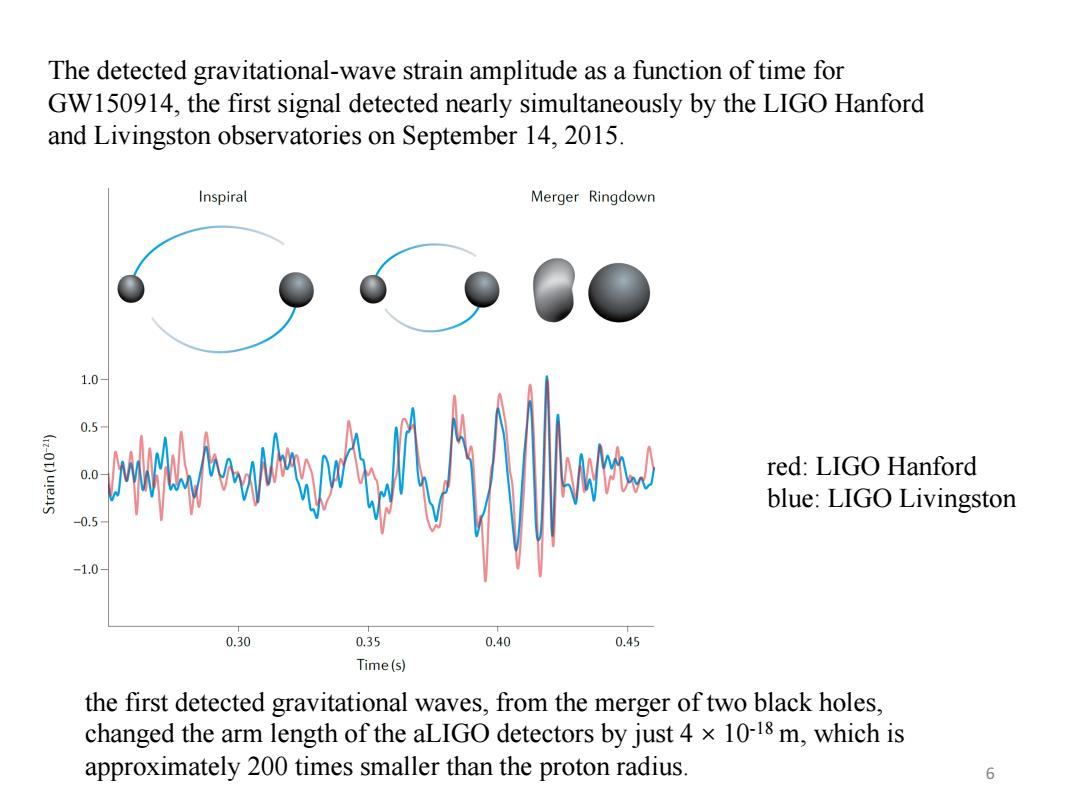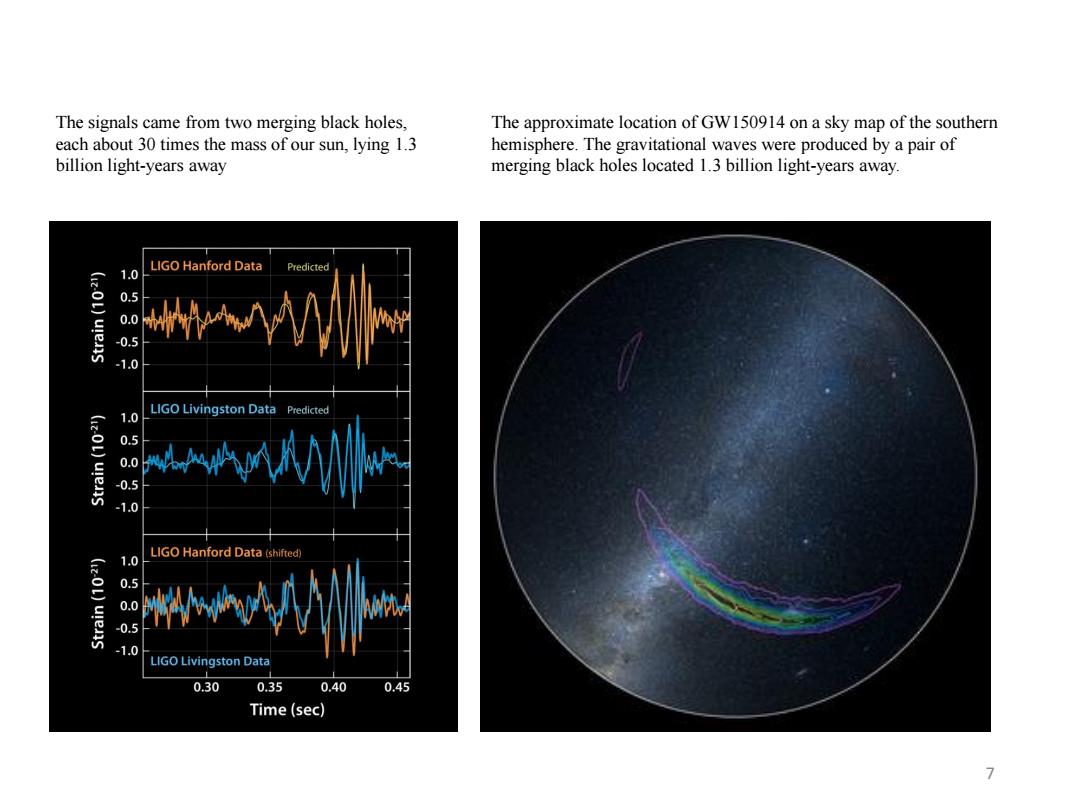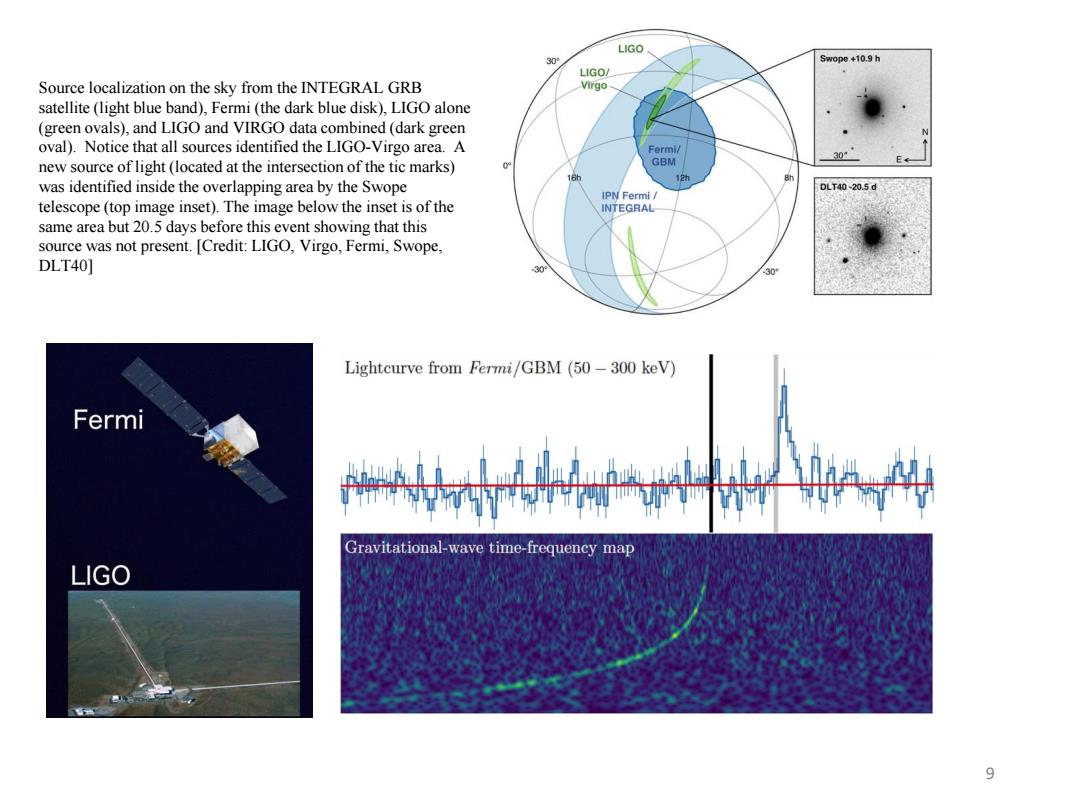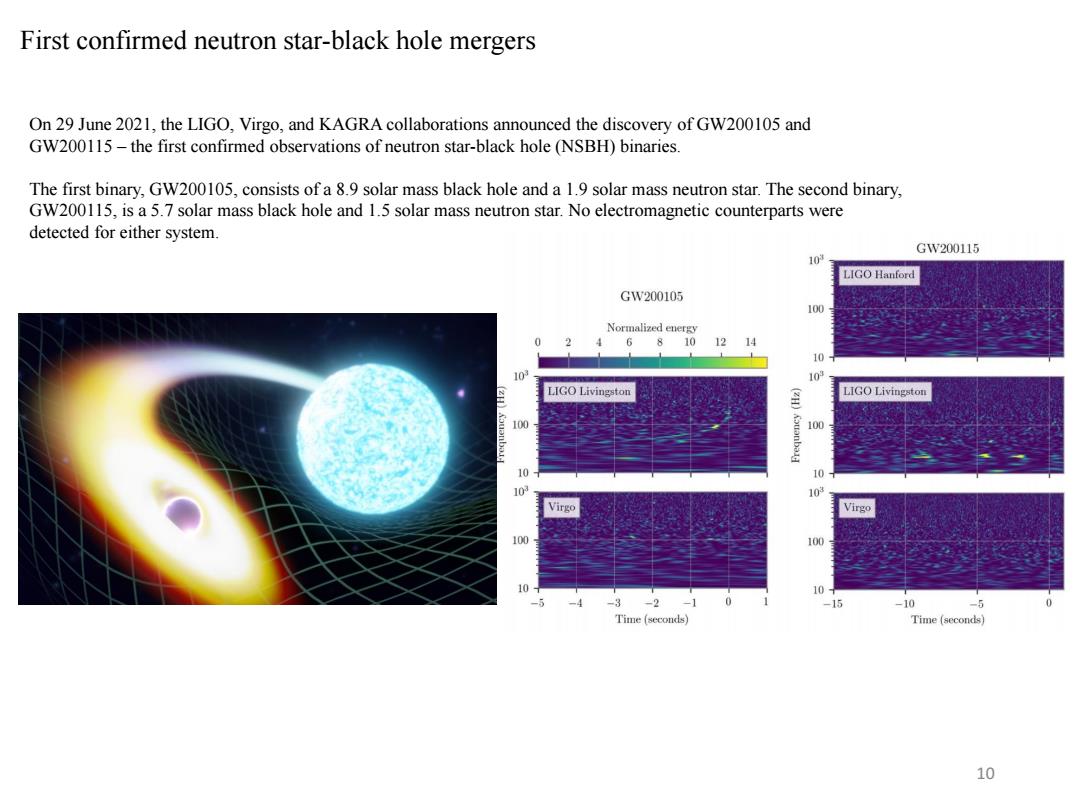
The detected gravitational-wave strain amplitude as a function of time for GW150914,the first signal detected nearly simultaneously by the LIGO Hanford and Livingston observatories on September 14,2015. Inspiral Merger Ringdown 1.0 0.5 7-OI) 0.0 oe red:LIGO Hanford blue:LIGO Livingston 0.5 10 0.30 0.35 0.40 0.45 Time(s) the first detected gravitational waves,from the merger of two black holes, changed the arm length of the aLIGO detectors by just 4 x 10-18 m,which is approximately 200 times smaller than the proton radius. 6
6 The detected gravitational-wave strain amplitude as a function of time for GW150914, the first signal detected nearly simultaneously by the LIGO Hanford and Livingston observatories on September 14, 2015. red: LIGO Hanford blue: LIGO Livingston the first detected gravitational waves, from the merger of two black holes, changed the arm length of the aLIGO detectors by just 4 × 10-18 m, which is approximately 200 times smaller than the proton radius

The signals came from two merging black holes, The approximate location of GW150914 on a sky map of the southern each about 30 times the mass of our sun,lying 1.3 hemisphere.The gravitational waves were produced by a pair of billion light-years away merging black holes located 1.3 billion light-years away. LIGO Hanford Data 1.0 Predicted (1z-OL)ulens 40 0.5 -1.0 LIGO Livingston Data Predicted 338 A 70 LIGO Hanford Data (shifted) 1.0 5 -1.0 LIGO Livingston Data 0.30 0.35 0.40 0.45 Time(sec) 7
7 The approximate location of GW150914 on a sky map of the southern hemisphere. The gravitational waves were produced by a pair of merging black holes located 1.3 billion light-years away. The signals came from two merging black holes, each about 30 times the mass of our sun, lying 1.3 billion light-years away

First binary neutron star detection/first electromagnetic counterpart GW 170817 was a gravitational wave(GW)signal observed by the LIGO and Virgo detectors on 17 August 2017,originating from the shell elliptical galaxy NGC 4993.The signal was produced by the last minutes of a binary pair of neutron stars'inspiral process,ending with a merger.It is the first GW observation that has been confirmed by non-gravitational means Normalized amplitude 0 2 4 6 14 500 1.3 x<0.05 LIGO-Hanford 1.2 x<0.89 100 1.0 50 500 08 LIGO-Livingston 9 0.6 1.251.501.752.002.252.502.75 100 m1 Mo] 0 5 30 500 Virgo 100 12h 50 -30 30 -30 -20 -10 0 25 50 75 Time(seconds) Mpe 8
8 GW 170817 was a gravitational wave (GW) signal observed by the LIGO and Virgo detectors on 17 August 2017, originating from the shell elliptical galaxy NGC 4993. The signal was produced by the last minutes of a binary pair of neutron stars' inspiral process, ending with a merger. It is the first GW observation that has been confirmed by non-gravitational means First binary neutron star detection/first electromagnetic counterpart

LIGO 30 Swope +10.9 h LIGO/ Source localization on the sky from the INTEGRAL GRB virgo satellite (light blue band),Fermi (the dark blue disk),LIGO alone (green ovals),and LIGO and VIRGO data combined(dark green oval).Notice that all sources identified the LIGO-Virgo area.A Ferml/ 30” new source of light (located at the intersection of the tic marks) 0 GBM 12幼 8h was identified inside the overlapping area by the Swope 的 DLT40-20.5d IPN Fermi telescope(top image inset).The image below the inset is of the INTEGRAL same area but 20.5 days before this event showing that this source was not present.[Credit:LIGO,Virgo,Fermi,Swope, DLT40] 30 30 Lightcurve from Fermi/GBM(50-300 keV) Fermi Gravitational-wave time-frequency map LIGO 9
9 Source localization on the sky from the INTEGRAL GRB satellite (light blue band), Fermi (the dark blue disk), LIGO alone (green ovals), and LIGO and VIRGO data combined (dark green oval). Notice that all sources identified the LIGO-Virgo area. A new source of light (located at the intersection of the tic marks) was identified inside the overlapping area by the Swope telescope (top image inset). The image below the inset is of the same area but 20.5 days before this event showing that this source was not present. [Credit: LIGO, Virgo, Fermi, Swope, DLT40]

First confirmed neutron star-black hole mergers On 29 June 2021,the LIGO,Virgo,and KAGRA collaborations announced the discovery of GW200105 and GW200115-the first confirmed observations of neutron star-black hole (NSBH)binaries The first binary,GW200105,consists of a 8.9 solar mass black hole and a 1.9 solar mass neutron star.The second binary, GW200115,is a 5.7 solar mass black hole and 1.5 solar mass neutron star.No electromagnetic counterparts were detected for either system. G1W200115 10 LIGO Hanford GWw200105 100 Normalized energy 6 810 1214 10 10 10 (H) LIGO Livingston LIGO Livingston 100 100 10 10 10 Virgo Virgo 100 100 10 -5 -3 -2-1 -15 -10 -5 Time (seconds) Time (seconds 10
10 On 29 June 2021, the LIGO, Virgo, and KAGRA collaborations announced the discovery of GW200105 and GW200115 – the first confirmed observations of neutron star-black hole (NSBH) binaries. The first binary, GW200105, consists of a 8.9 solar mass black hole and a 1.9 solar mass neutron star. The second binary, GW200115, is a 5.7 solar mass black hole and 1.5 solar mass neutron star. No electromagnetic counterparts were detected for either system. First confirmed neutron star-black hole mergers